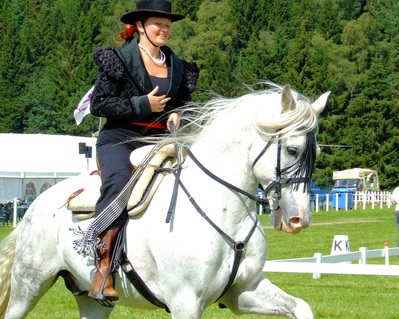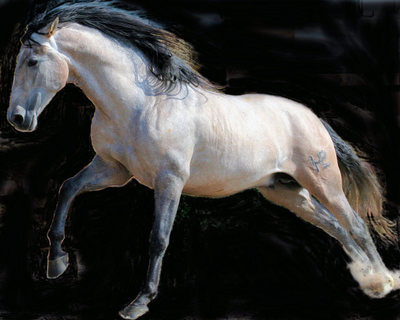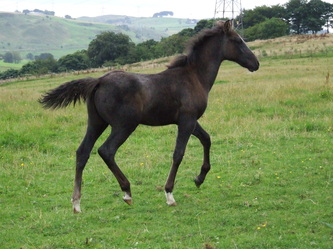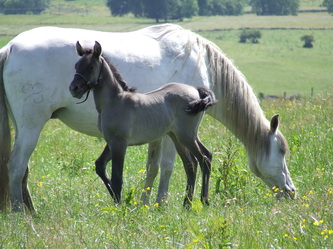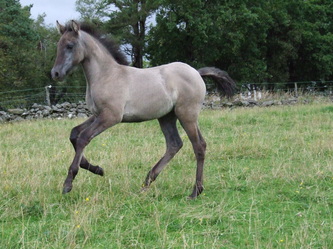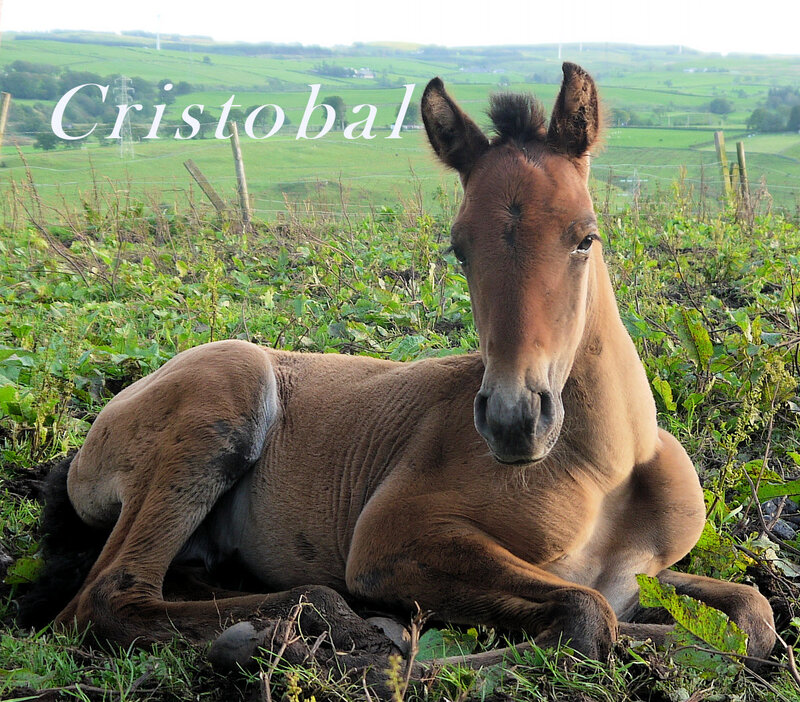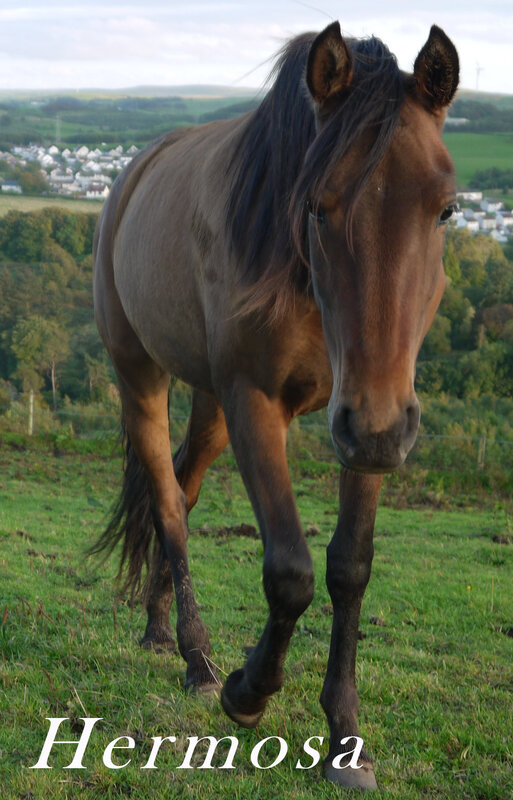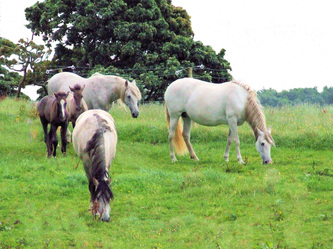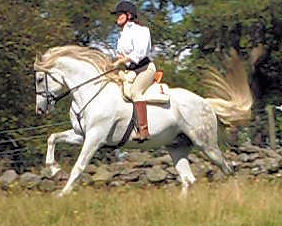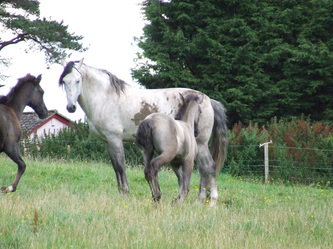BREEDERS OF P.R.E. ANDALUSIAN HORSES
YOUNGSTOCK FOR SALE
|
Contact us!
Foreside Farm, Fereneze Road, By Neilston, Glasgow G78 3AQ Landline: 0141 880 5422 Mobile: 07837 0800 58 View our other web page www.foreside.org.uk CARTHUSIAN STALLIONS
ANCIENT BREED
The Andalusian, also known as the Pure Spanish Horse or PRE (Pura Raza Española), is a horse breed developed in the Iberian Peninsula. Its ancestors have been present on the Iberian Peninsula for thousands of years. The Andalusian has been recognized as an individual breed since the 15th century, and its conformation has changed very little over the centuries. Throughout its history, it has been known for its prowess as a war horse, and was prized by the nobility. The breed was used as a tool of diplomacy by the Spanish government, and kings across Europe rode and owned Spanish horses. During the 19th century, warfare, disease and crossbreeding reduced herd numbers dramatically, and despite some recovery in the late 19th century, the trend continued into the early 20th century. Exports of Andalusians were restricted until the 1960s, but the breed has since spread throughout the world, despite still-low population numbers. As of 2003, there were over 75,000 registered living Andalusians worldwide. Strongly built, and compact yet elegant, Andalusians have long, thick manes and tails. Their most common coat color is gray, although they can be found in many other colors. They are known for their intelligence, sensitivity and docility. A sub-strain within the breed known as the Carthusian, is considered by breeders to be the purest strain of Andalusian, though there is no genetic evidence for this claim. The strain is still considered separate from the main breed however, and is preferred by breeders because buyers pay more for horses of Carthusian bloodlines. There are several competing registries keeping records of horses designated as Andalusian or PRE, but they differ on their definition of the Andalusian and PRE, the purity of various strains of the breed, and the legalities of stud book ownership. At least one lawsuit is in progress as of 2010 to determine the ownership of the Spanish PRE stud book. The Andalusian is closely related to the Lusitano of Portugal, and has been used to develop many other breeds, especially in Europe and the Americas. Breeds with Andalusian ancestry include many of the warmbloods in Europe as well as western hemisphere breeds such as the Azteca. Over its centuries of development, the Andalusian breed has been selected for athleticism and stamina. The horses were originally used for classical dressage, driving, bullfighting, and as stock horses. Modern Andalusians are used for many equestrian activities, including dressage, show jumping and driving. The breed is also used extensively in movies, especially historical pictures and fantasy epics. Andalusian breed has over the centuries been consistently selected for athleticism. In the 17th century, referring to multi-kilometer races, Cavendish said, "They were so much faster than all other horses known at that time that none was ever seen to come close to them, even in the many remarkable races that were run." From the very beginning of their history, Andalusians have been used for both riding and driving. Among the first horses used for classical dressage, they are still making a mark in international competition in dressage today. At the 2002 World Equestrian Games, two Andalusians were on the bronze-medal winning Spanish dressage team, a team that went on to take the silver medal at the 2004 Summer Olympics. Today, the breed is increasingly being selectively bred for increased aptitude in classical dressage. Historically, however, they were also used as stock horses, especially suited to working with Iberian bulls, known for their aggressive temperaments. They were, and still are, known for their use in mounted bull fighting. Mares were traditionally used for la trilla, the Spanish process of threshing corn practiced until the 1960s. Mares, some pregnant or with foals at their side, spent full days trotting over the corn. As well as being a traditional farming practice, it also served as a test of endurance, hardiness and willingness for the maternal Andalusian lines. The Andalusian breed is truly ancient, and it's noble strength and gentleness is the stuff of legend. Trouble is, once you've owned one, or experienced the floating gracefulness under saddle, you'll be spoiled for anything else. Their stud book goes back unbroken, to the 15th Century. The oldest stud book in the world! BREEDING Available for both PRE Apto registered mares, and for producing Part Bred foals, these boys are offering an opportunity for mare owners to produce spectacular foals with ancestors that go back into the mists of time. Jealously guarded by the Carthusian monks at great peril for centuries, then taken into control of the Spanish Military who made it illegal to export PRE stock from Spain till the laws relaxed in the 1980's. Even now, the slightest mistake or suspicion can leave an eligible PRE cut off from entry into the Spanish State Stud Book for itself and all its progeny. GRADING Strict Grading Procedures by the representatives from Spain are done at 3 years of age. Failure on many points including conformation and temperament, incurs a life long ban. * Only a Veterinary Surgeon recognised and licensed by the Spanish government, can fill in the passports and take the blood for DNA testing in Seville for PRE foals. |
